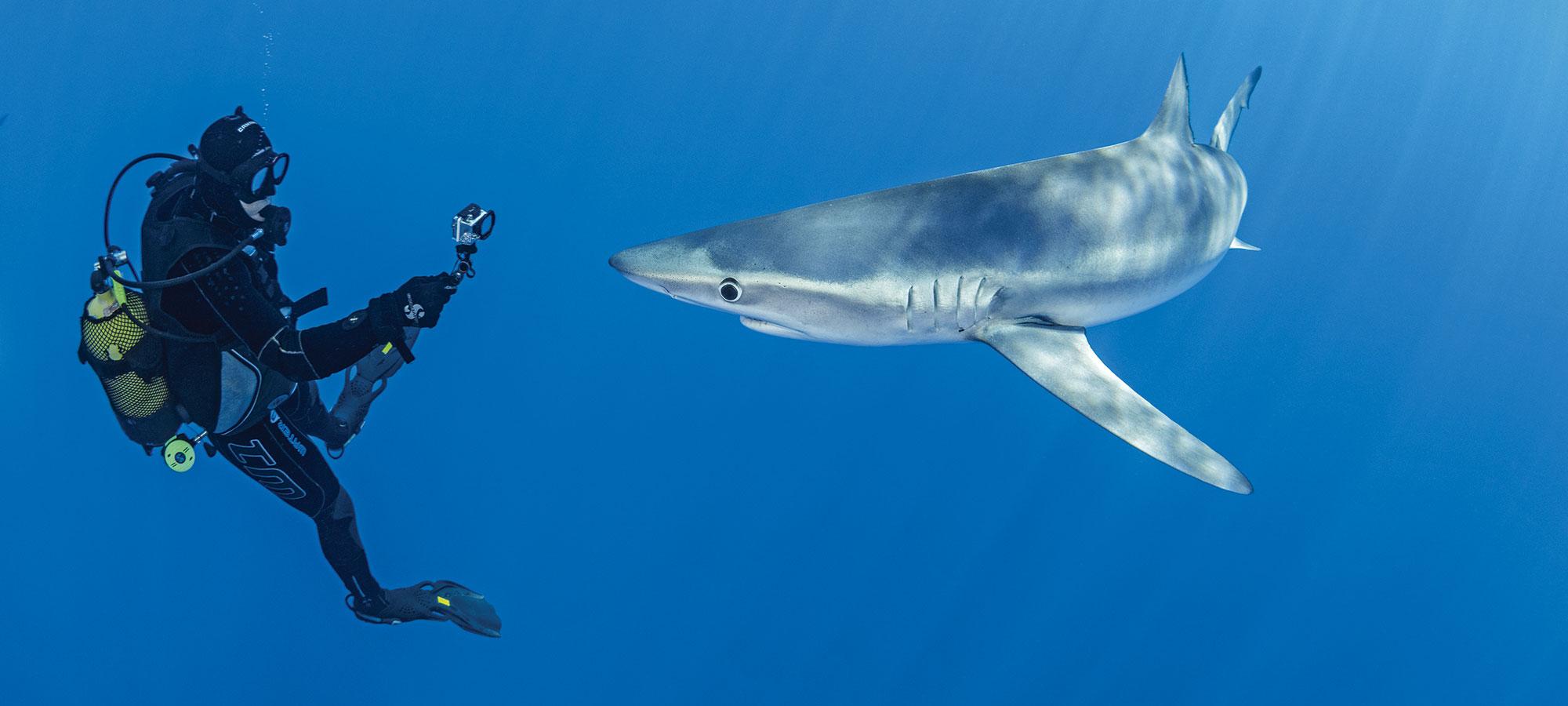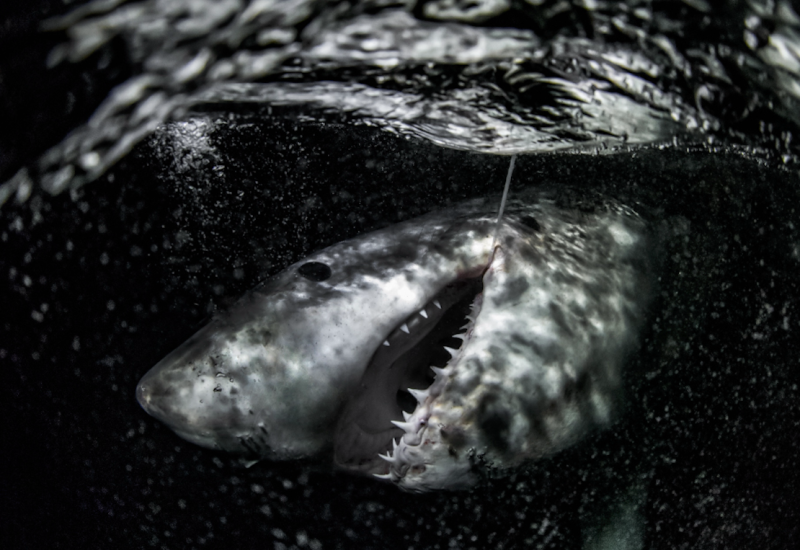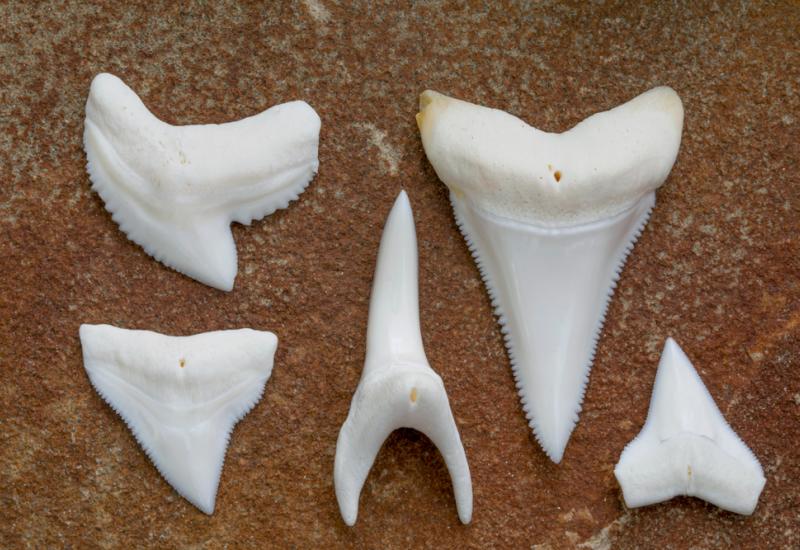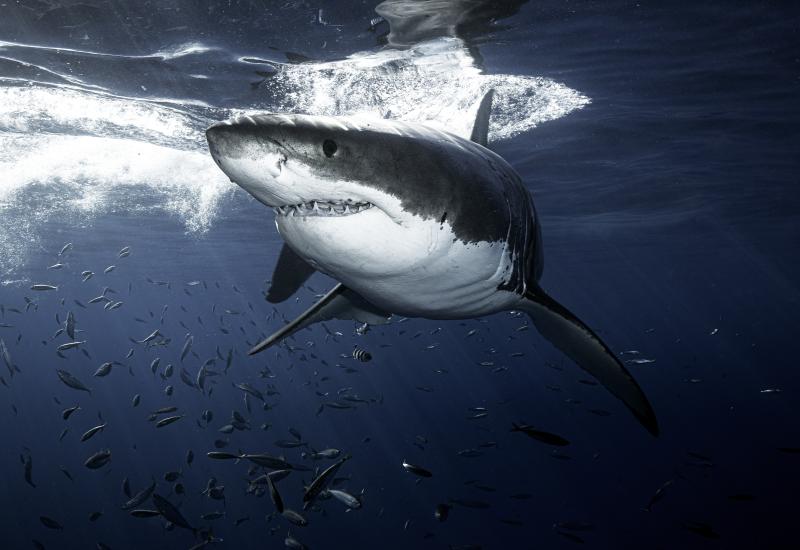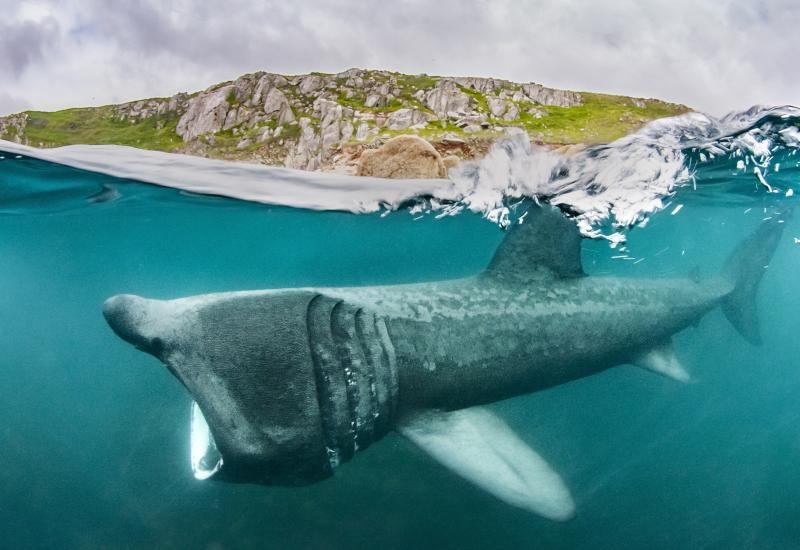Epic Pelagic Action Awaits Divers in the Azores
There must be something in the water. Or perhaps the volcano has infused me with electromagnetic properties. How else to explain the 7-foot-long blue shark currently staring at me? Curious and unblinking, it patiently provides me with the best photo ops I’ve ever had of this svelte pelagic wanderer—this while yesterday’s close-up encounter with mobulas continuously replays in my mind. The science, or magic, behind the state of current affairs out here in the middle of the Atlantic is way beyond me. What’s obvious, however, is the magnetic personality of the Azores in general—and Pico Island in particular. Twenty years after my first visit, I’ve been drawn back for my third. This trip has been charmed indeed.
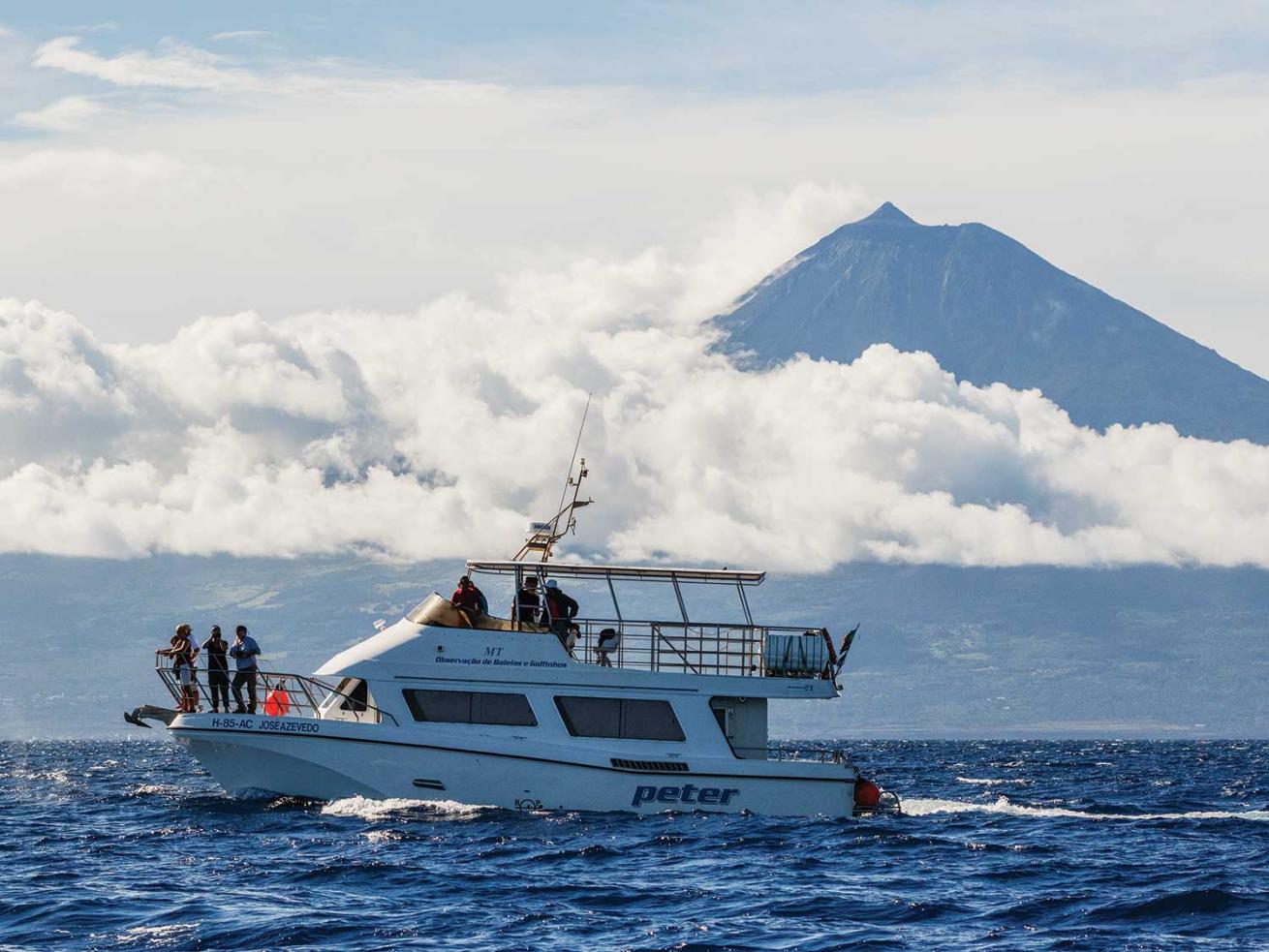
Brandon ColeMount Pico provides the perfect backdrop.
Pico is one of nine islands in the Azores, an archipelago and autonomous region of Portugal roughly 1,000 miles west of the European mainland. Pico’s verdant flanks are crowned by imposing Mount Pico, a stratovolcano that is the highest point in the country at 7,713 feet above sea level. The Azores is a hotspot both geologically and biologically. Often described as an oasis in a vast, blue desert, it’s home to more than 20 species of whales and dolphins. The subtropical waters support gamefish, sea birds, turtles, sharks, rays and a host of reef dwellers from gregarious groupers to tie-dyed wrasses.
LOCATION AND MIGRATION
Marine life loves the Azores, and so do the two-legged. Sailors have been stopping by for centuries to reprovision while traversing the Atlantic and to seek safe ports in storms. Stroll along Horta’s harbor on Faial Island—just 4 miles across the channel from our home base of Madalena on Pico—and you’ll see colorful flags from countless nations painted on the breakwater, evidence that modern yachties also drop anchor here. When you walk into a dive shop, prepare to meet and greet members of the worldwide dive tribe.
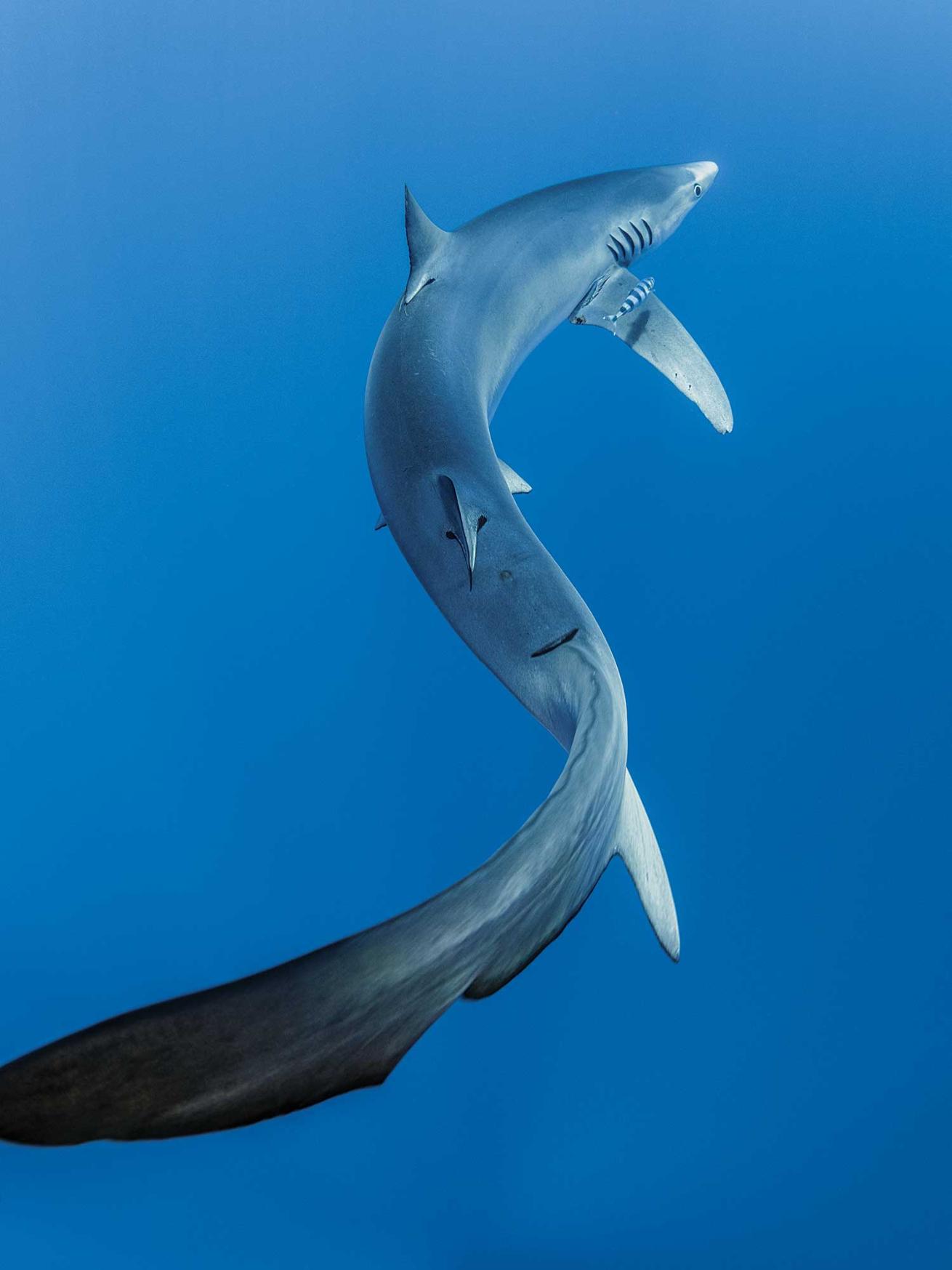
Brandon ColeA blue shark is propelled by its powerful tail fin.
On our first day, before our regs have even kissed the sea, we bump into friends from Ireland I haven’t seen in years, a fellow photographer from Slovakia, and a cosmopolitan group from across Europe. Dripping wet and smiling wide, they’ve just trudged into CW Azores headquarters in their scuba kits, babbling about blue sharks. Another equally diverse and ebullient group, windblown and wearing life jackets, has returned from a successful whale-watch ecotour. I catch a reverential potwal (sperm whale) here and a chirpy golfinho pintado (spotted dolphin) there as they show each other camera LCDs glowing with goodness. We’ve all come to the right place at the right time, migrating on a mission to this mid-Atlantic outpost.
DEJA BLUE
My own mission is threefold. First up is quality face time with Prionace glauca, the blue shark. Over the past decade, the Azores has buoyed to the top of the planet’s prime places to photograph this beautiful species, which is now endangered in some locations. I remember diving in Southern California circa 1988 when we’d see five to 20 on a splash, but my past few attempts there this decade have seen me bat 0-for-3.
We stop 28-foot Mermaid at a nondescript patch of ocean called Pedra do Sousa a few miles northwest of Pico to drop a bucket of chummy encouragement. Ninety minutes later, calls go up simultaneously: “Shark!” from our divemaster, and “Tubarão!” by Leonildo Leal, our homegrown skipper from Pico. My wife, Melissa, and I exchange high-fives with our friends Alastair McIntosh and Rakel Otero, a dynamic Scot and Spaniard duo from Berlin for whom a trip to the Azores is but a quick jaunt, akin to what we would make to Cabo. We buddy-check, camera-check, and then slide quietly into the deep.
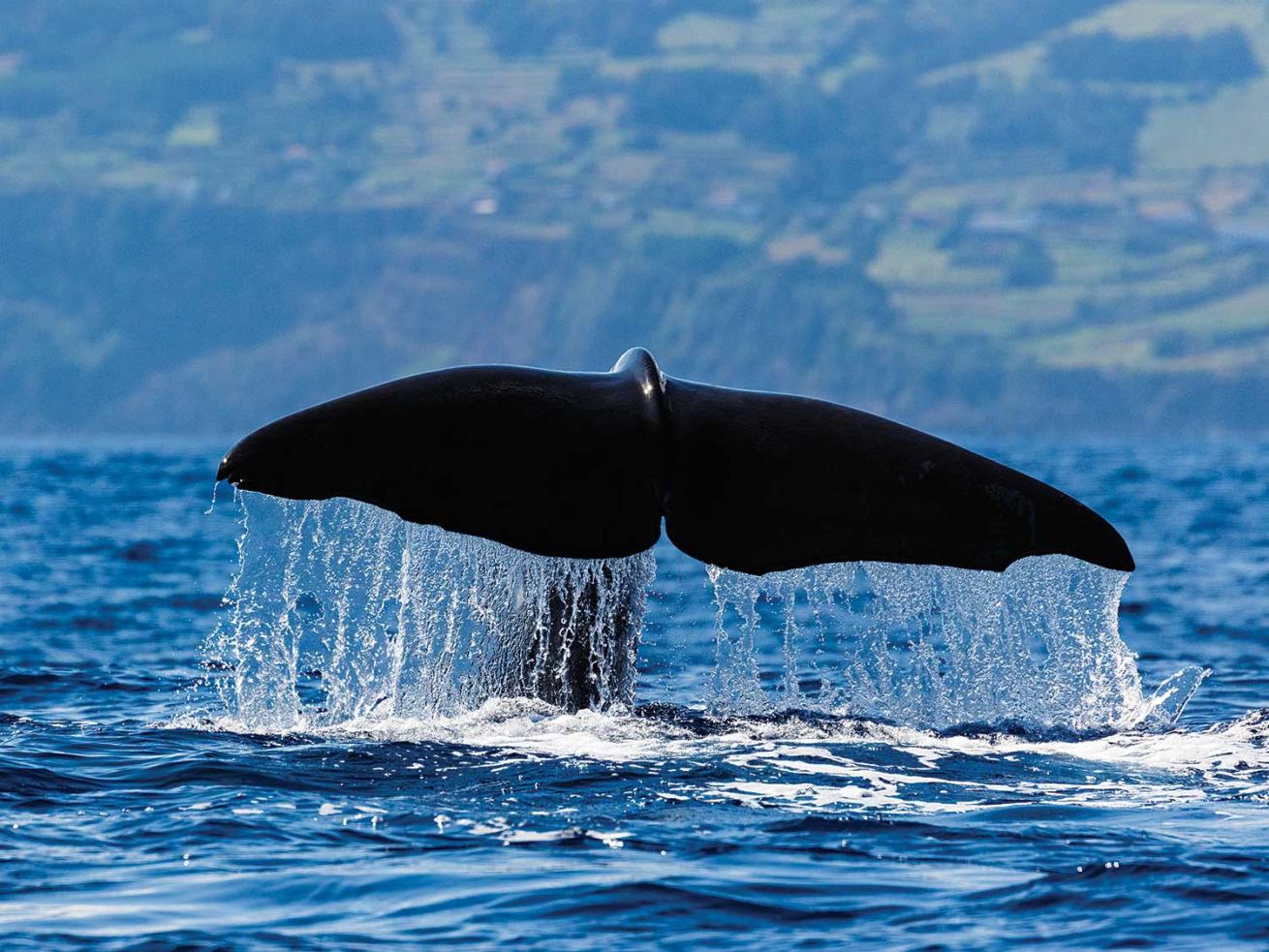
Brandon ColeA sperm whale dives deep.
We grab the stern downline at 10 feet. The shark approaches. For Melissa, this is a solemn moment, and a milestone—the first time she has ever seen a blue shark. For me, it is a heartfelt reminder of why I chose the life aquatic. For who knows how long, I forget to take a picture as this master of cerulean innerspace glides gracefully around us, confident and close. This is so much better than I dared hope. I know nothing imaged on a CMOS sensor by photodiodes and the cabal of microchip technology can ever truly capture the organic perfection live in front of me; the way the light beams are bent by the sinuous sweep of the shark’s tail, or that brief but profound connection made when its eye swivels to meet mine. Eventually habit and reflex take over, and I slip into the zone, my hands working the camera’s controls. I must at least try to freeze this moment in time so I can carry some part of this experience back onto land.
Two hours later, we climb into the boat. The silence between the four of us says it all. The spoken word would be as out of place now as it was underwater.
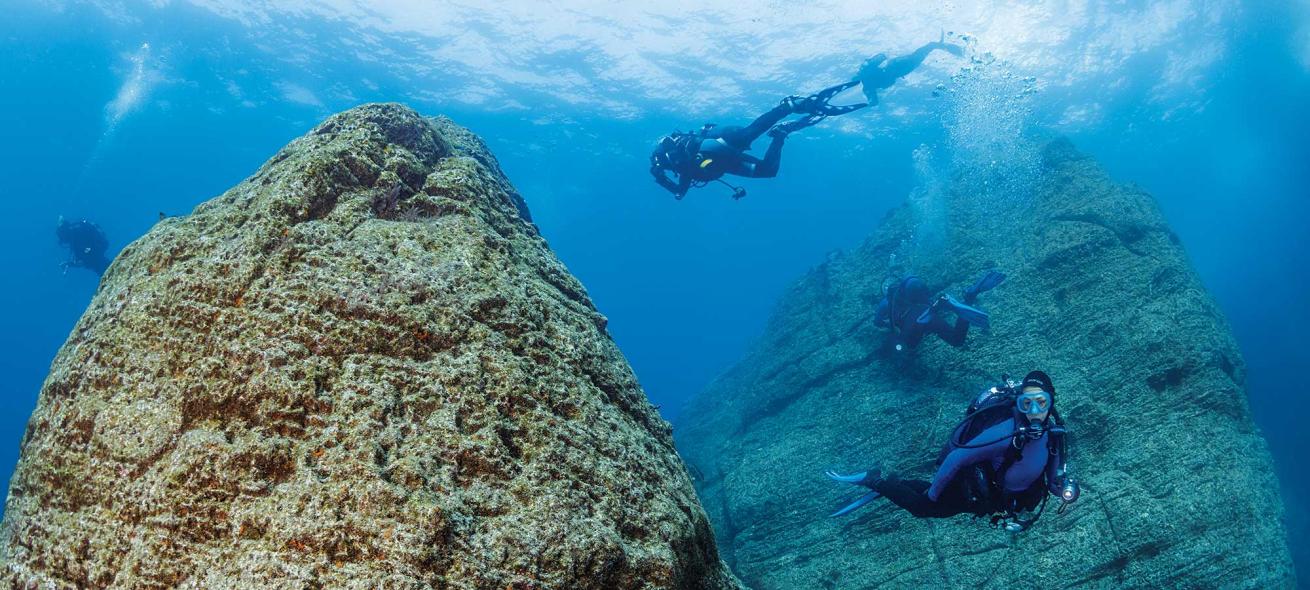
Brandon ColeThe Azores’ volcanic origin is evident.
CRITTERS AND CAVES
Blue sharks are primarily summer-time visitors—passing by deepwater structures like Condor Bank and Pedra do Sousa as they go about their mysterious migratory ways—but many of the celebrities in the Azores are residential. At Eagle Ray Cave off Faial’s southeast corner, we spy bat rays near their namesake cave’s entrance and a ball of barracuda before we descend to 80 feet to hang with the local friendly mero. The 3-foot-long dusky grouper makes a beeline for me to gaze at its own handsome reflection in my dome port. If only all subjects were so obliging. At Ilha Preta, moray eels show us their snaggleteeth, and an octopus lights up electric blue while parachute hunting. Strong current and cool upwellings liven up things at the Pinnacle between Pico and Faial, where we find schools of skipjack, Mediterranean parrotfish bright as scarlet macaws flapping about, and waves of wrasses in a kaleidoscope of colors.
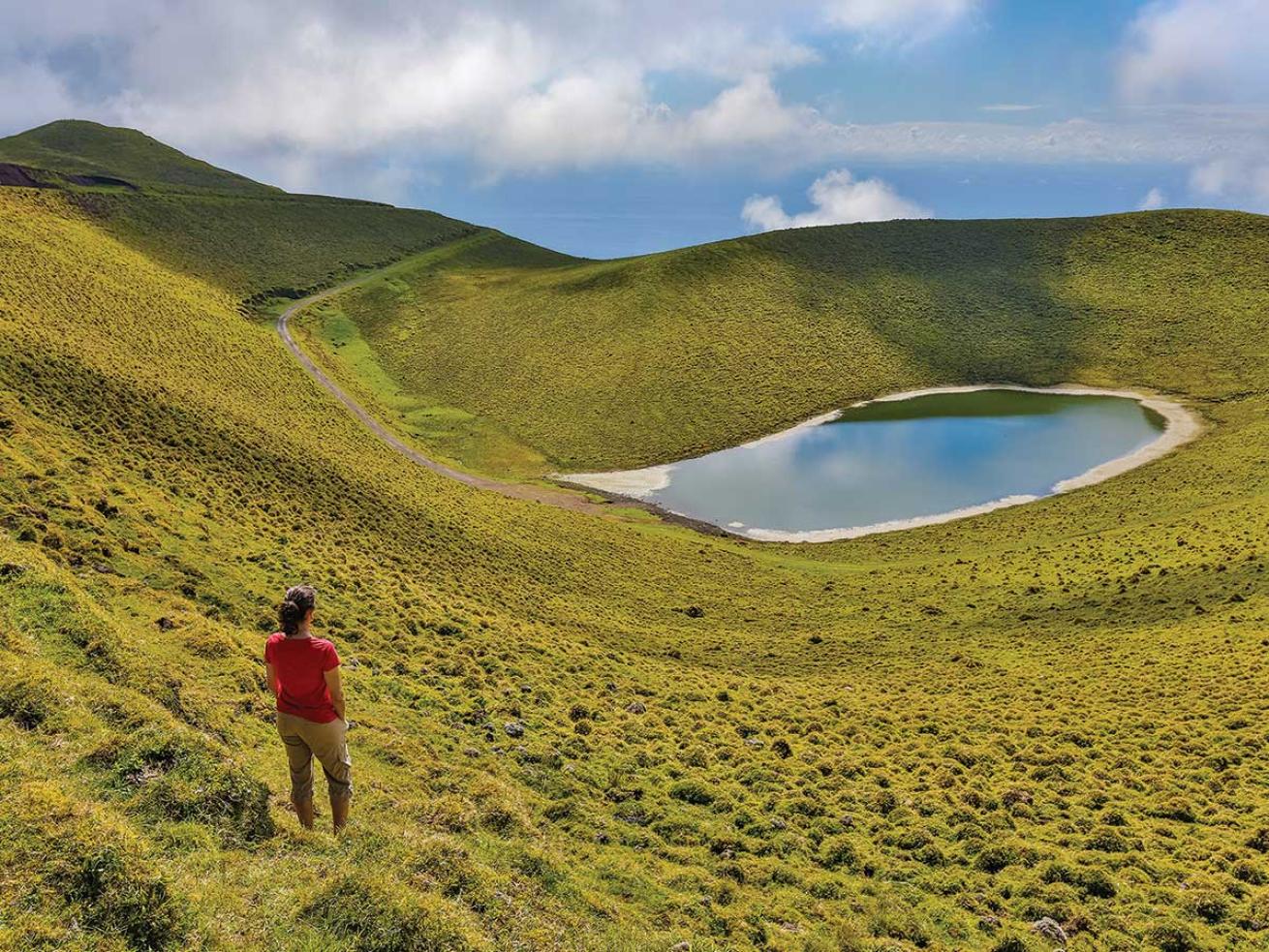
Brandon ColeHiking on Mount Pico reveals gorgeous settings.
Dramatic volcanic architecture awaits on nearly every dive. A craggy, single-file-wide fissure in the sheer rock face at Shrimp Cave leads into a hidden—you guessed it—cave, its walls alive with thousands of marching shrimp sporting red and white racing stripes. Ilheus has jagged ridges, gigantic boulders, sculpted and striated plunging walls, and sand channels where stingrays hunker down and fish fly. On some days, there’s washing-machine surge and ripping current along the southern side of this caldera just outside Madalena’s tranquil harbor. Off Pico’s northwest corner at Formosinha Arches, our divemaster guides us through a maze of lava tunnels and under soaring archways into stately chambers with cathedral ceilings bright in orange zoanthids. We have Mount Pico’s tumultuous temperament to thank for all of this inspired bottomography.
After three straight days of reef diving, we gratefully salute the volcano from the terrace of chic Cella Bar, lifting glasses of local white vinho Verdelho made from grapes grown right here on Pico’s slopes. We feast on seafood so fresh, it must have just crawled, flopped and swum out of the sea, and right onto our plates. Obrigado!
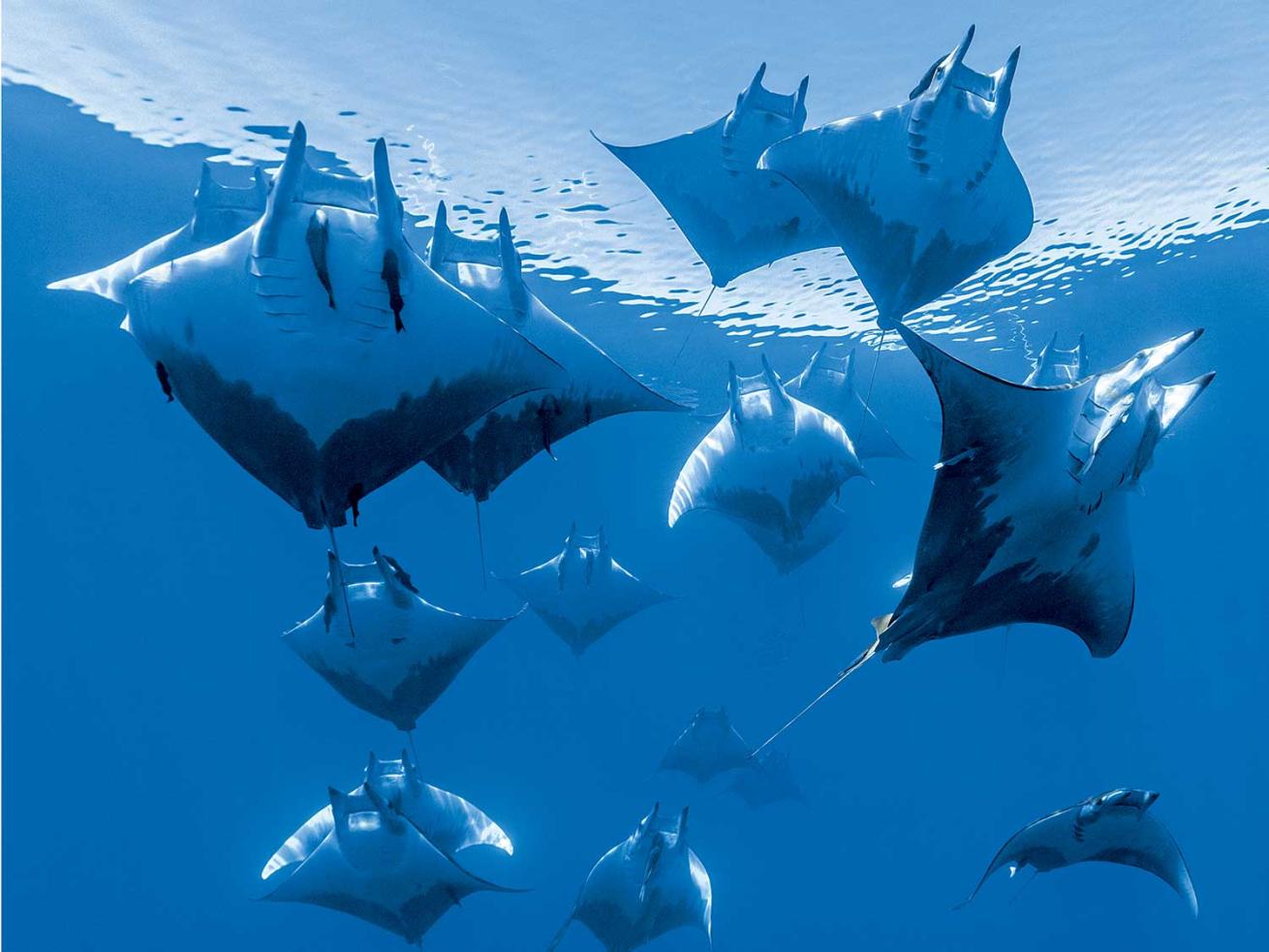
Brandon ColeSicklefin devil rays pass in a group.
SOJOURN WITH CETACEANS
My first two trips to Pico in the late 1990s were all about whales. Organized shark diving was not yet on the map, but whale and dolphin ecotourism had caught on. A scientific permit allowed me to photograph resident cachalotes (local lingo for sperm whales). In the process, I ran into 10 additional marine-mammal species.
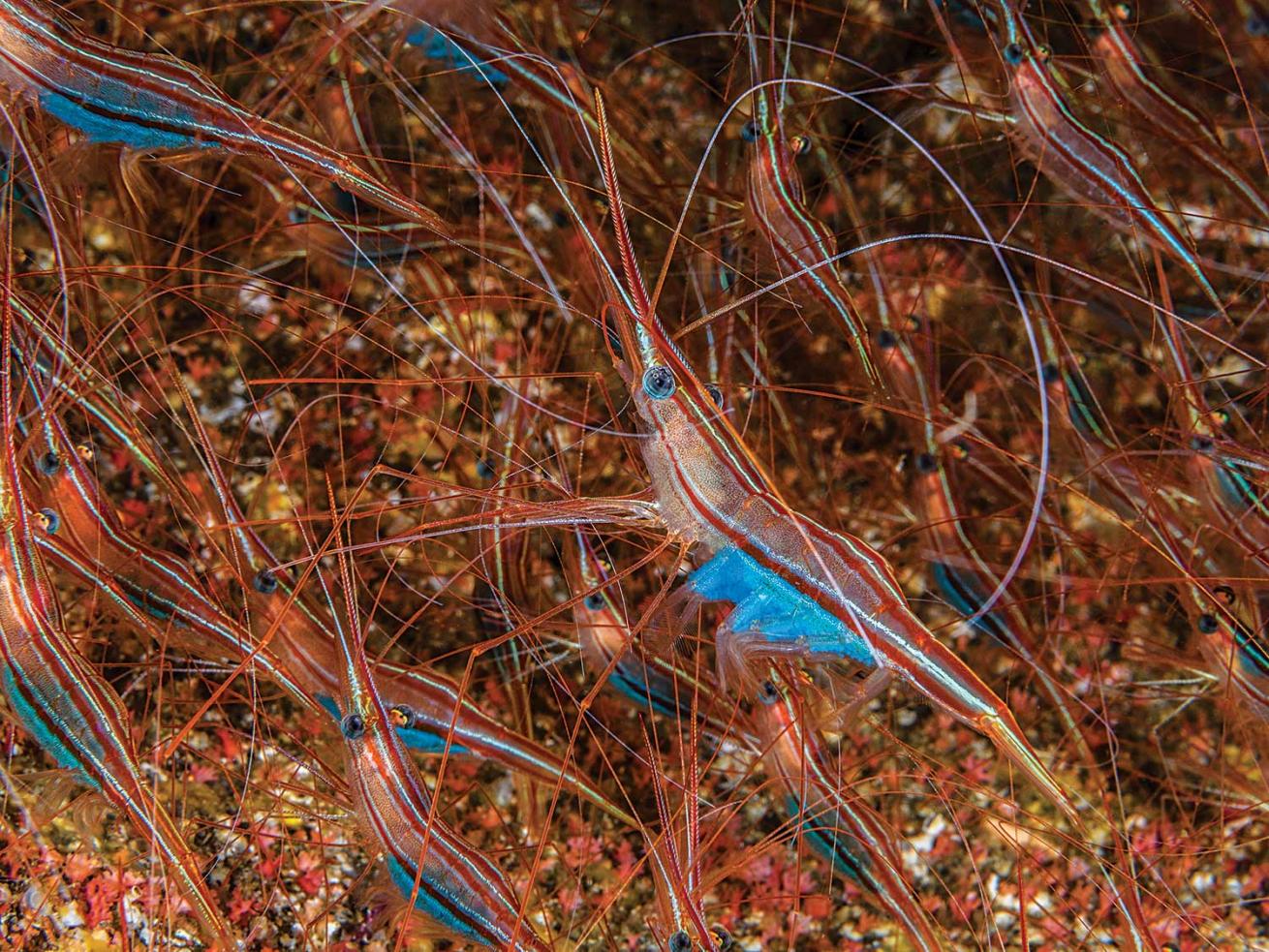
Brandon ColeNarwal shrimp cover the walls of a sea cave.
The Azores today remains one of the world’s premier spots for sightings of everything from blue whales to striped dolphins. Topside observation of sperm whales and their baleen cousins can be easily enjoyed with many licensed operators, as can swimming with dolphins. Melissa and I raced alongside a rambunctious herd of hundreds of acrobatic spotted dolphins one day, and snorkeled with a more mellow group the next.
The second compelling reason for my comeback tour was to revisit these cetacean-rich waters in search of a spout on the horizon belonging to the leviathan. It didn’t take long. On our first outing with captain Michael Costa (a co-founder of CW Azores and an expert in all things whale), “Thar she blows!” was exclaimed in a handful of languages in the first 30 minutes. Just a few miles off Pico’s northern coast, we found a family group of nine socializing sperm whales. Two tiny calves only 12 or 13 feet long, watched over by mothers and pod mates, were floating at the surface, rubbing up against each other. Historically, this was a killing ground: Until 1987, the men of Pico were still commercially hunting these very animals. Now, it’s a sanctuary. The transformation is yet another allure of the Azores.
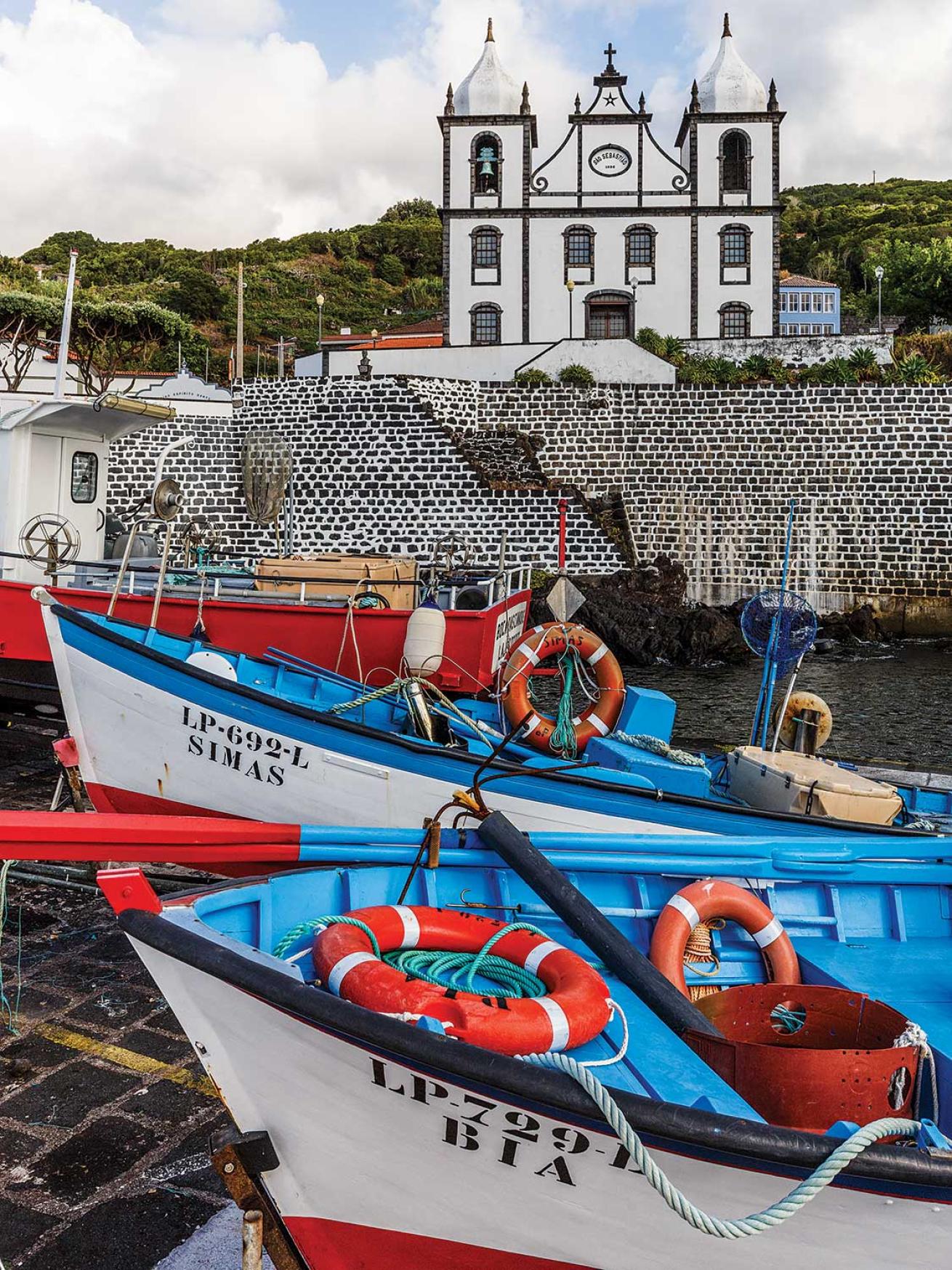
Brandon ColeA church on Pico’s coast.
PELÁGICA FANTÁSTICA
We’re skimming southwest at 20 knots when the sun’s rays peek over the volcano’s shoulder, setting gauzy clouds to glowing. Five miles down, 40 more to go. The third stage of my quest is underway.
Two hours later we arrive at Princess Alice Bank, a seamount shooting up from nearly 5,000 feet to plateau at 110. Another boat with scientists on board is already on-site. They’re here for the same reason I am: sicklefin devil rays. This mountain in the middle of the Atlantic Ocean is a magnet for mobulas. Nowhere else in the world is Mobula tarapacana known to aggregate in large numbers.
We stop at 40 feet, hanging on the anchor line. The current blows us horizontal like flags in the wind. A pair of wahoo saunters by, then barracuda, then amberjack. After an immense shoal of bonito flashes past, a half-dozen mobulas wing into view, but they are 30 feet distant, and our tanks are low. Our safety stop is spent watching one of the scientists freedive down to adroitly attach a torpedo-shaped tag to a ray. Through the use of these noninvasive, high-tech data loggers, researchers are learning about the diving profiles, movement patterns and social behavior of this enigmatic elasmobranch.
Whereas the first dive was merely excellent, the second splash at Princess Alice ranks beyond epic. Not three minutes gone, and I’m mobbed by a mobula. It swoops straight in, flares its wings wide, and parks above my head. Another ray, 8 feet wide and caramel-colored on top with remoras dangling below, circles our group a few times before favoring Melissa with a super-close eye-to-eye pass, forging a bond between human and alien spaceship never to be forgotten. Sometime later—a few heartbeats or perhaps 30 minutes—things get really crazy when a squadron of rays materializes out of the blue. I’m able to squeeze only 23 of them into one picture. There were more.
Clambering back into the boat, I’m pleasantly at a loss as to how one can top this dive. Thankfully, tomorrow—our last day in the Azores—we’ve scheduled another shark dive. I have a feeling that more pelágica fantástica awaits us.
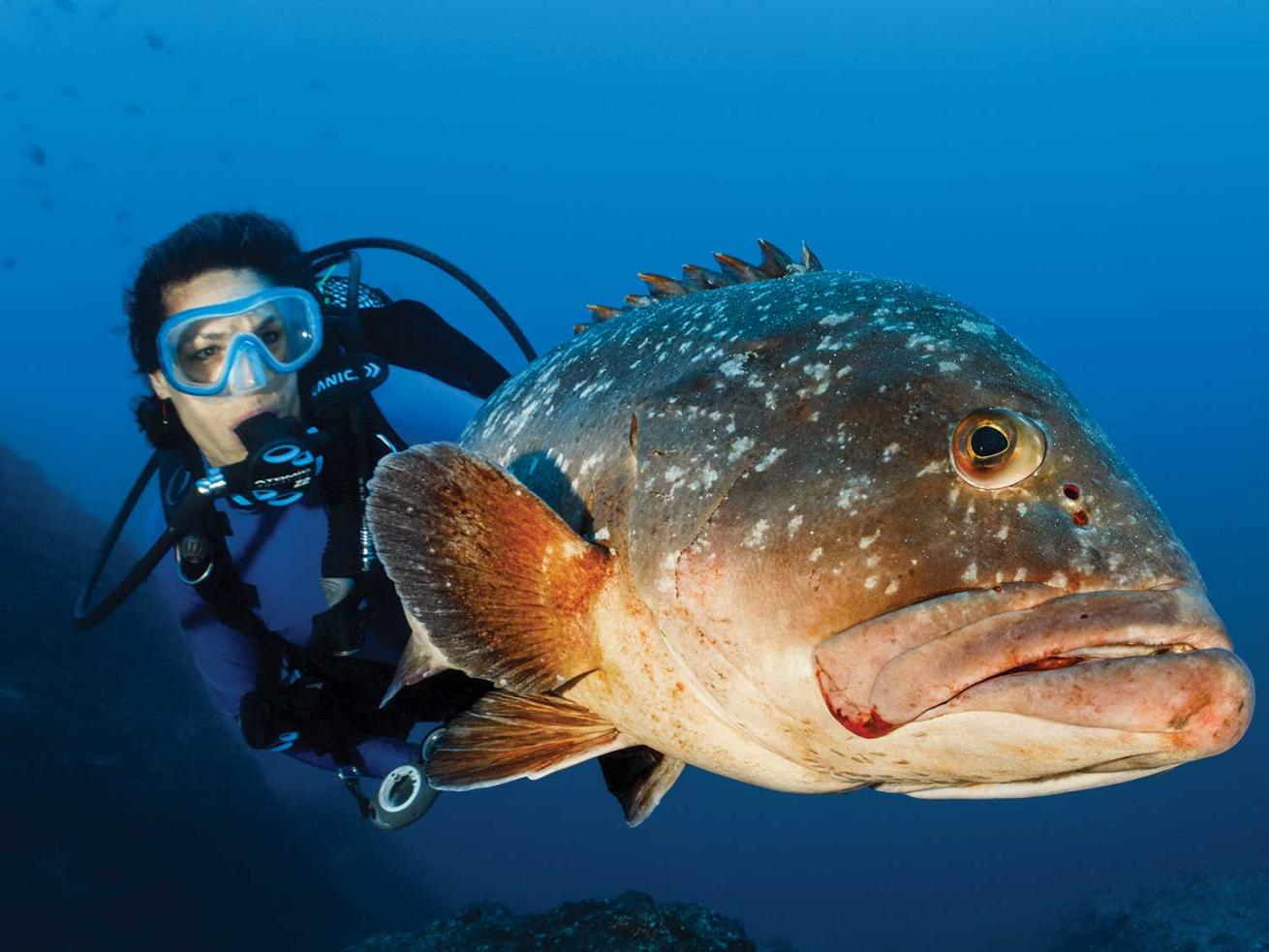
Brandon ColeA dusky grouper cozies up to a visiting diver.
NEED TO KNOW
When to Go: Pico’s diving season is April through October. Blue sharks, mobula rays and other pelagic action are best July to early October. Whale-watching season runs March through October.
Traveler Tips: Spend an afternoon—or better yet, two days—getting to know Pico Island. Hike up the volcano, visit whale museums, explore lava caves, and partake of local wines and cheeses. Consider an extension in Lisbon on the mainland, a very cool city full of culture, great food, friendly people and beautiful architecture.
Dive Conditions: Sea temperatures range from 65°F in spring to 77 in September. Bring a 5 mm or 7 mm full wetsuit and a hooded vest. Visibility at coastal sites varies from 30 feet in spring to 80 feet or more in late summer and fall. Offshore visibility often exceeds 100 feet. Most dive sites are suitable for beginner divers. The remote location and likelihood of strong currents at Princess Alice Bank necessitate strict safety protocols; it’s best for advanced divers.
Operators: For diving and whale tours on Pico, CW Azores (cwazores.com) is an experienced operator. Pick Norberto Diver (norbertodiver.pt) on Faial Island.
Price Tag: CW Azores offers a 10-night Adventure Package that includes diving, whale-watching, dolphin swimming, accommodations and transfers. For 2019, the price is around $1,600 per person, double occupancy.

